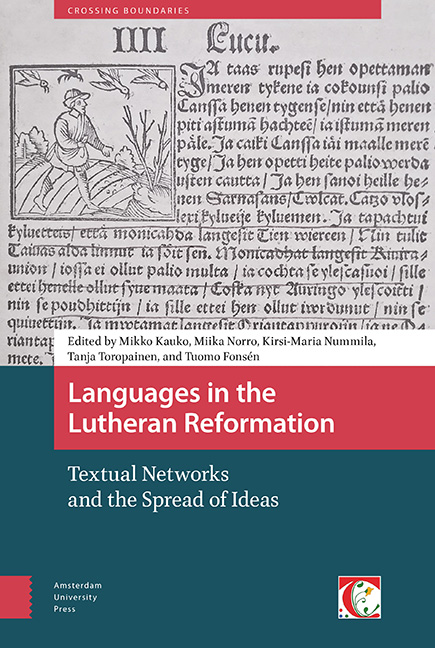Book contents
- Frontmatter
- Contents
- List of Figures and Tables
- Preface
- Introduction
- Part I The Reception of Luther's Ideas and their Influence for the Development of Written Languages
- Part II Effects of Bible Translations on the Evolution of Written Language
- Part III Reuse of (Catholic) Texts after the Reformation
- Part IV Language Contacts and Loanwords
- Index
12 - German Influence on the Christian Discourse of Early Written Latvian
Published online by Cambridge University Press: 21 November 2020
- Frontmatter
- Contents
- List of Figures and Tables
- Preface
- Introduction
- Part I The Reception of Luther's Ideas and their Influence for the Development of Written Languages
- Part II Effects of Bible Translations on the Evolution of Written Language
- Part III Reuse of (Catholic) Texts after the Reformation
- Part IV Language Contacts and Loanwords
- Index
Summary
Abstract
The focus of this essay is the influence of German on early written Latvian, in particular on Christian discourse. The background for the themes dealt with is formed by loan-based cultural phenomena (the Christian religion and the Lutheran Reformation) and the loan-based texts (above all biblical texts) relating to the phenomena and their translation. The study examines the vocabulary and idioms of Christian discourse in the early 16th and 17th centuries, and also the morphological and syntactic structures, in terms of their origin. Early written Latvian was, in practice, a language translated from German, which was clearly reflected in the difference between the written and the spoken language. The influence of German on the written language was even more pronounced because the writers either spoke German as their mother tongue or they had a very good command of German. The influence of German and the resulting obscurity of the texts remained characteristic features of the language of Christianity until in the 19th century.
Keywords: Language contact, language transfer, loanwords, Latvian, German, Old Russian
Introduction
The Christian paradigm was one of the central paradigms in the early period of the history of written languages of the people in the Baltic region. The very beginnings of the written language are connected with the spread of Christianity, especially with the Reformation movement in the 16th century. The early written sources of Latvian are connected with the Reformation, the period when the idea of the translation of the Bible and use of vernaculars in worship spread over many parts of Europe and also found their place in Livonia. The earliest preserved books in Latvian are Catholic (1585) and Lutheran (1586) catechisms. Even the early short and fragmentary texts in Latvian from the first half of the 16th century were mostly connected with Christianity: they were prayers or other formulae used in Christian rituals.
Nevertheless, the history of Christianity in the Baltic area is longer and begins with the Christianization of the entirety of northern Europe in the 9th century. This was the period when the two branches of Christianity met on the eastern shore of the Baltic Sea – the Western branch from Rome and the Eastern from Byzantium.
- Type
- Chapter
- Information
- Languages in the Lutheran ReformationTextual Networks and the Spread of Ideas, pp. 273 - 302Publisher: Amsterdam University PressPrint publication year: 2019



